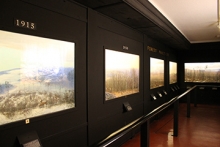You are here
Fisher Museum to Close for Renovations; Archive Seeks Pre-1970s Photos

The Harvard Forest Fisher Museum, free and open to the public since 1941, will close for renovations on October 31, 2016, and reopen in April 2017.
The Museum's 23 diorama models will be protected and remain unchanged during the renovation, which will primarily focus on the Museum's entryways, flooring, lighting, and auditorium space. Harvard Forest's interpretive trails will remain open during the renovations.
The newly renovated Museum will include an exhibit on the history of the Fisher Museum and the making of the dioramas. But there is a gap in our archival records of the space.
"Those who have been visiting the Fisher Museum for decades may remember the way the Museum looked before it was renovated in the 1970s," says David Foster, Director of the Forest since 1983. "It had high ceilings and an upper gallery with displays and windows that allowed natural light to stream down from above. We welcome stories from local residents of their memories of the Museum, including any photographs or news clippings related to those years before 1970." These can be directed to Clarisse Hart, Outreach Manager, at hart3@fas.harvard.edu or 978-756-6157, for consideration for the Archive.
An auditorium was placed in the center of the Museum in the 1970s—and is now home to an increasing number of workshops, public events, and symposia. Many agencies and organizations, including the Mount Grace Land Conservation Trust and the Mass. Department of Conservation & Recreation, hold annual meetings in the space. More than 5,000 people annually visit the Fisher Museum, including local schoolchildren and families, university students, and groups of foresters, policymakers, conservationists, and scientists from every continent.
The 23 dioramas portray 200 years of landscape change in Central New England, and meticulously illustrate forest management practices from the early twentieth century. They figure into countless publications, books, and educational materials around the world.
The dioramas were created in the 1930s by the Guernsey and Pitman studio in Cambridge, Mass. According to Time Magazine, they were the most celebrated exhibit at Harvard University's Tercentenary in 1936, when over 100,000 people viewed them on display in Cambridge. The dioramas moved to Petersham in 1941; the brick building where they are found was built specifically to house them.
One diorama depicts Harvard Pond, a well-known landscape in Petersham, and includes a figurine of the Forest's founding director, Richard Fisher, for whom the Museum was named.
The building renovations, funded by the Harvard University Faculty of Arts and Sciences and overseen by Roland Meunier of the Harvard Forest Woods Crew, will be partly completed in-house and, as is typical for Harvard Forest, partly contracted to local businesses.

